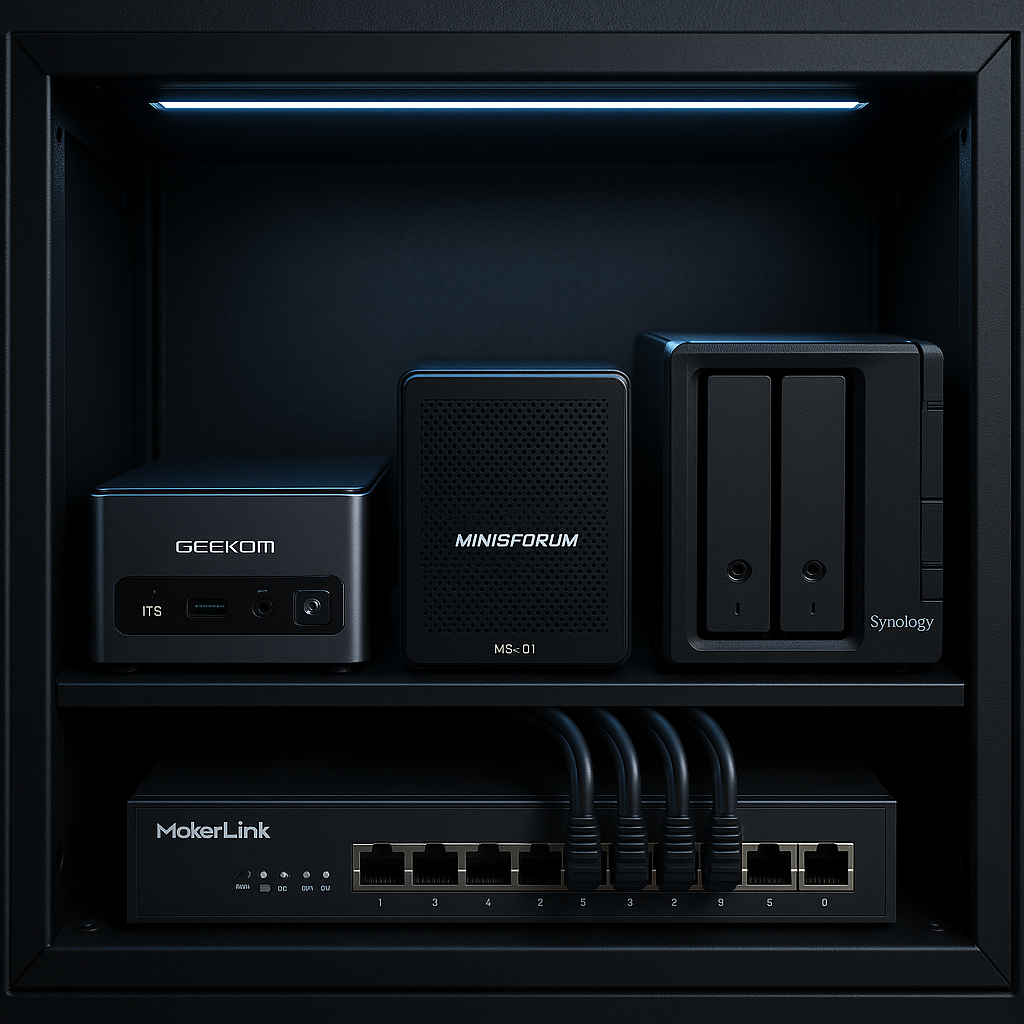My inaugural blog post! I’ve chosen to kick things off by sharing the details of my Homelab setup, which I use for experimenting and testing software. This setup also serves as the host for running this website.
In the past, I explored various homelab configurations using desktop PCs, Synology NAS devices, and Raspberry Pis to run virtual machines or Docker containers. Specifically, the desktop PCs were quite noisy and not very energy-efficient. Meanwhile, the Synology NAS and Raspberry Pis didn’t provide enough performance for my needs. Last year, I felt it was time for a change. Having been pleased with my Intel NUC as a desktop computer, I decided to shift towards Small Form Factor PCs due to their compact size (which is obviously beneficial), energy efficiency, and the fact that many others have successfully implemented them in their homelab setups.
Previously, I was utilizing ESXi, but due to the changes in their licensing policy, I chose to explore Proxmox Virtual Environment instead. Eventually, it became my primary hypervisor, so I needed to ensure that the hardware was compatible with its specifications. For more information on the requirements, visit https://www.proxmox.com/en/products/proxmox-virtual-environment/requirements
‘m looking for a Mini PC with the following specifications:
– A minimum of 64GB of memory to enable me to run several Linux VMs for Docker, and eventually, testing Kubernetes/OpenShift in a clustered environment. It should also have the capacity to virtualize a few Windows systems, though not simultaneously.
– An Intel Core i5 or higher processor or an AMD Ryzen 5 would suit my needs.
– At least one SSD or M.2 NVMe slot dedicated for the Proxmox OS.
– An additional M.2 NVMe PCIe Gen4 slot intended for Virtual Machines/LCX Containers; some will require high I/O performance due to database demands.
– A minimum of one 2.5G RJ45 port since I’ve been facing slow network issues in the past.
I began searching for Asus/Intel NUCs, but the prices of NUCs have skyrocketed compared to what they were before COVID. As a result, I started exploring other brands. This led me to the mini PCs listed below. I also repurposed some hardware I already owned, such as the Samsung SSD and Kingston NVME, so this might not be the most optimal setup. Currently, I’m utilizing local storage with replication; however, I’ll delve into that in another blog post. In the near future, I’m looking to invest in a high-performance NAS for NFS storage and low IO devices. The Minisforum N5 is becoming a strong contender for my preferences moving forward.
| Brand and type | Specs | Verdict |
|---|---|---|
| Geekom IT13 | – Intel i7-13620H: 10 cores, 16 theads -> Efficient Cores: 4 Cores, 4 Threads, 1.8 GHz Base, 3.6 GHz Turbo -> Performance Cores: 6 Cores, 12 Threads, 2.4 GHz Base, 4.9 GHz Turbo – 64 GB DDR4 – 500 GB Samsung 850 EV SSD – M.2 NVMe Samsung 980 Pro 2 TB – M.2 2242 SATA TS1TMTS425S 1 TB – 2.5G RJ45 ports | Good performance, quiet fan after BIOS update, average M.2 NMVe slots heat dissipation |
| Minisforum MS-01 | – Intel Core i5-12600H: 12 cores, 16 threads -> Efficient 8 Cores, 8 Threads, 2.0 GHz Base, 3.3 GHz Turbo -> Performance Cores: 4 Cores, 8 Threads, 2.7 GHz Base, 4.5 GHz Turbo – 64 GB DDR5 – M.2 NVMe Seagate Firecuda 530 2TB – M.2 NVMe KINGSTON OM8PGP41024N-A0 1TB – 2 x 2.5G RJ45 ports, 2 x 10 Gbps SFP | Average performance, quiet and good M.2 NMVe slots heat dissipation. Fan noise on high load. |
What I learned
II’ve been running my homelab for about a year now, set up as a Proxmox cluster. It includes several LXC containers, a Linux server running around 12 Docker containers, AWX on Minikube, a Kubernetes cluster for testing/learning, and two old Windows desktops that I’ve virtualized and occasionally power on.
I have plenty CPU power, memory, and disk I/O. However, under high load, the fan noise from the Minisforum system can be a bit annoying — though the spikes in load (and noise) usually only last a few seconds.
One major improvement I’ve noticed is in the NVMe cooling on the Minisforum. Better cooling has clearly helped reduce NVMe wear, and it’s something I’ll prioritize more when selecting future hardware — especially in terms of heat dissipation for both storage and memory.
The 2.5G Ethernet ports also make a noticeable difference in overall network performance — everything runs much more smoothly.
I’ll admit I haven’t spent much time optimizing load distribution between the mini PCs, but even so, I’m very happy with the setup. The performance exceeds my expectations.
Let me know if you have any comments or questions.

